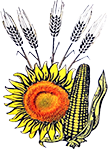Researches Concerning the Evolution of the Diamondback Moth (Plutella xylostella) in Autumn Oilseed Rape Crop, in South-East of Romania
Emil Georgescu1, Lidia Cană1, Luxița Rîșnoveanu2,3, Roxana Zaharia4, Georgeta Trașcă4,5
1Institutul Național de Cercetare-Dezvoltare Agricolă Fundulea
2Academia de Studii Economice București
3Stațiunea de Cercetare-Dezvoltare Agricolă Brăila
4Institutul de Cercetare-Dezvoltare pentru Protecţia Plantelor București
5Stațiunea de Cercetare-Dezvoltare Agricolă Albota
Keywords: colza, diamondback moth, seed treatment.
Abstract: This is the first paper from the Romanian literature that reveals a high diamondback moth larva (Plutella xylostella) attacked an oilseed rape crop in autumn in the southeast of this country. This study has monitored the invasion of the larva of this pest at an autumn oilseed rape, at NARDI Fundulea, between 2019 and 2021. At the same time, it has monitored the fly patterns of the adults of this specie with pheromone traps. Field observations have effectuated at untreated variant (control) and variant with seeds treated by new technology, with the active ingredient of new generation cyantraniliprole (625 g/l), belonging to the diamide class. In the autumn of 2019, the attack degree was 3.04% in the control variant, while in the variant with treated seeds, the attack degree was 2.72%. In the autumn of 2020, it registered the highest attack of the diamondback moth larva; at the control variant, the attack degree was 16.26%, while in the variant with treated seeds, the attack degree was 11.24%. In the year 2021, the diamondback moth larva was insignificant, at the control variant, the attack degree was 0.27%, while in the treated variant, and attack degree was 0.14%.
Concerning larva density from oilseed rape experience, in the autumn of the year 2019, on 20 November, at the control variant, it has registered 0.61 larva/plant, while at the variant with treated seeds, it has registered 0.53 larva/plant; in the autumn of the year 2020, on 11 November, at control variant, it has registered 1.81 larva/plant, and at treated seeds variant it has registered 1.64 larva/plant, while in the autumn of the year 2021, at the end of November and beginning of December, it has registered an insignificant level of the pest pressure, at both experimental variants, the density was bellow 0.10 larva/plant. The results of the fly pattern monitoring of the diamondback moth make evidence that in 2019 and 2020, it was three fly peeks, highest captures number registered in November (88.50 captures/trap on 20.11.2019, respectively, 104.00 captures/trap on 24.11.2020), while in 2021 it was two maximum fly peeks, highest captures number registered on 17 June (80.25 captures/trap). The new seeds treatment technology effectively protects the oilseed rape plants in the first vegetation stages against diamondback moth larva. Data obtained in this study effectuated it the southeast of Romania, suggesting that the diamondback moth becomes the primary pest of oilseed rape crop during autumn.
